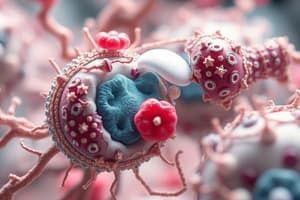Podcast
Questions and Answers
What is the primary function of mitochondria?
What is the primary function of mitochondria?
- Synthesis of proteins
- Packaging and distribution of materials
- Detoxification of foreign substances
- Energy generation and metabolism (correct)
Peripheral proteins are embedded within the lipid bilayer of the cell membrane.
Peripheral proteins are embedded within the lipid bilayer of the cell membrane.
False (B)
What is the role of lysosomes in a cell?
What is the role of lysosomes in a cell?
They contain digestive enzymes that destroy cells or foreign matter.
The cell membrane is selectively ________, regulating transport materials in and out.
The cell membrane is selectively ________, regulating transport materials in and out.
Match the following organelles with their functions:
Match the following organelles with their functions:
What is the primary function of ribosomes in a cell?
What is the primary function of ribosomes in a cell?
The smooth endoplasmic reticulum is responsible for protein synthesis.
The smooth endoplasmic reticulum is responsible for protein synthesis.
What are the two main types of cells?
What are the two main types of cells?
The _____ is the control center of the cell, containing the cell’s DNA.
The _____ is the control center of the cell, containing the cell’s DNA.
Match the cellular structures to their functions:
Match the cellular structures to their functions:
Flashcards are hidden until you start studying
Study Notes
Cell Overview
- Cells are the basic units of all living organisms.
- Two main types of cells: Eukaryotic (with nucleus) and Prokaryotic (without nucleus).
Characteristic Functions of Cells
- Metabolism and energy use: Cells perform biochemical processes to generate energy.
- Synthesis of molecules: Cells create essential compounds for function and structure.
- Communication: Cells interact and send signals to each other.
- Reproduction and inheritance: Cells reproduce and pass genetic material to the next generation.
Microscopy Techniques
- Light Microscopes: Allow observation of general cell features.
- Electron Microscopes: Reveal fine structures.
- Scanning Electron Microscope (SEM): Observes surface features.
- Transmission Electron Microscope (TEM): Shows detailed internal structures.
Cellular Structures and Organelles
External Structures
- Cilia: Cylindrical projections for movement; 10 μm long and 0.2 μm in diameter.
- Flagella: Longer than cilia at 45 μm; primarily found on sperm cells.
- Microvilli: Not for movement; enhance absorption, found in intestines and kidneys.
Internal Structures
- Cytoplasm: Gel-like substance containing all organelles, excluding the nucleus.
- Cytosol: Fluid portion of the cytoplasm, includes cytoskeleton and inclusions.
- Cytoskeleton: Composed of microtubules, actin filaments, and intermediate filaments; provides structural support and facilitates movement.
Nuclear and Cytoplasmic Organelles
-
Nucleus: Largest organelle; contains the cell's DNA and acts as the control center.
- Contains chromosomes, chromatin, nucleoplasm, nuclear envelope, nucleolus, and nuclear pores.
-
Ribosomes: Sites of protein synthesis located in the cytosol or attached to membranes.
-
Endoplasmic Reticulum (ER): Network of membranes; two types:
- Rough ER: Studded with ribosomes, involved in protein synthesis.
- Smooth ER: Lacks ribosomes, synthesizes lipids, detoxifies substances, and stores calcium ions.
-
Golgi Apparatus: Processes, packages, and distributes materials within the cell.
Lysosomes and Energy Organelles
- Lysosomes: Contain digestive enzymes; responsible for breaking down waste and foreign material.
- Mitochondria: Powerhouse of the cell; site of cellular metabolism and energy production.
- Peroxisomes: Contain enzymes for detoxification, especially in the liver and kidney.
Plasma Membrane
- Structure: Composed of 45-50% lipids, 45-50% proteins, and 4-8% carbohydrates.
- Function: Selectively permeable barrier that regulates material transport in and out of the cell.
Membrane Potential and Proteins
- Membrane Potential: Electrical charge difference across the membrane due to ion regulation.
- Membrane Proteins: Include integral and peripheral proteins, serving roles in transport, signaling, and support.
Transport Mechanisms
Passive Transport
-
Diffusion: Movement of solutes from high to low concentration.
- Simple Diffusion: Direct movement through the lipid bilayer.
- Facilitated Diffusion: Involves carrier proteins for polar substances.
-
Osmosis: Diffusion of water across a semipermeable membrane, influenced by osmotic pressure and tonicity (isotonic, hypertonic, hypotonic).
Active Transport
- Primary Active Transport: Direct use of ATP to move substances against a concentration gradient.
- Secondary Active Transport: Utilizes the movement of one substance to drive the transport of another.
- Vesicular Transport: Movement of large volumes using vesicles (includes endocytosis and exocytosis).
Genes and Gene Expression
- Gene Expression: Process of producing RNA and proteins from DNA, consisting of:
- Transcription: DNA is transcribed into RNA.
- Translation: RNA is translated into proteins.
Cell Life Cycle
- Stages: Interphase and Cell Division.
Interphase
- G1 Phase: Cell growth and preparation for DNA replication.
- S Phase: DNA replication occurs.
- G2 Phase: Cell prepares for mitosis, replenishes energy, and duplicates organelles.
Cell Division
- Mitosis Stages:
- Prophase: Chromosomes condense; nuclear membrane dissolves.
- Metaphase: Chromosomes align at the cell center.
- Anaphase: Chromosomes are pulled apart to opposite poles.
- Telophase: Nuclear membrane reforms; cell readies for division.
- Cytokinesis: Final step where cytoplasm divides, forming two new cells.
Studying That Suits You
Use AI to generate personalized quizzes and flashcards to suit your learning preferences.



